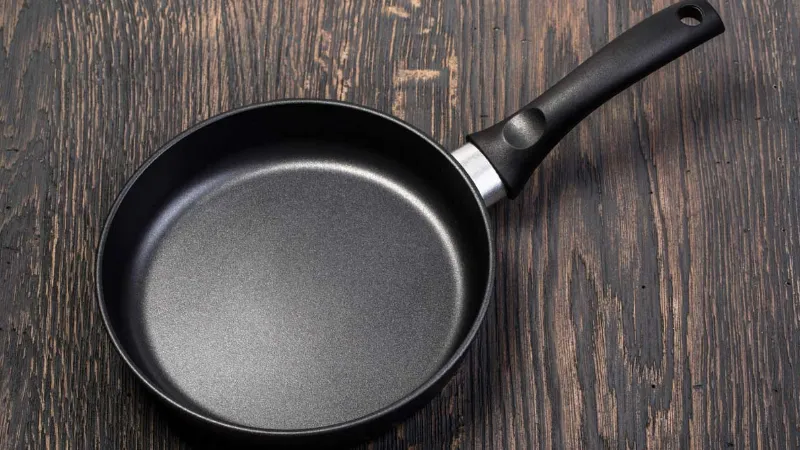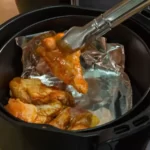Can You Microwave Plastic Wrap: Is It Safe Really
First, can you microwave plastic wrap? YES!
The USDA says plastic wrap is actually safe to use in the microwave, as long as it’s labeled microwave-safe. The advice is to keep the plastic wrap away from the food itself, which is more important.
Many of us believe it is unhealthy for us to use plastic wrap or any other plastic-related products. According to this theory, food products made of plastic can absorb hazardous chemicals that are toxic to human health and harmful to the environment.
Others simply disregard these issues and routinely use plastic wrap in the microwave without any hesitation.
Please read on for more information about whether plastic wrap can be microwaved, which I will illustrate in more detail in this post.
Table of Contents
Is It Safe To Microwave Plastic Wrap?
Plastic wrap can be safely microwaved. The best course of action is to inspect the plastic wrap’s quality and confirm its microwave-safety using the label.
To use plastic wrap in a microwave oven without any hesitation, you should always use the plastic wrap that has been approved for use in a microwave.
Even if you’re using plastic wrap that can be heated in a microwave, you still need to keep the timing to a minimum, set the microwave power level to low or medium, and keep the food away from the plastic wrap while it’s heating.
You can use plastic wrap in the microwave safely in this situation.
Plastic Wrap In A Microwave?
Following some fundamental guidelines is necessary if you’re using plastic wrap in a microwave.
- Use a dish or bowl with high sides.
- Keep some space between the food’s surface and the plastic wrap.
- On low or medium power, set the microwave oven’s heating temperature.
- Never heat plastic wrap for longer than two minutes.
How Much Time Can Plastic Wrap Be Microwaved?
You should not keep the plastic wrap in the microwave oven when eating foods higher than 150 degrees Fahrenheit.
You can leave plastic wrap in the microwave for about 20 minutes when using low power levels. At high temperature levels, use plastic wrap for less than 2 minutes.
It is acceptable to use in the microwave oven while reducing heating time and temperature as long as you are using a microwave-proof plastic wrap.
Best Way To Use Plastic Wrap In The Microwave
According to the USDA, plastic wrap is actually safe to use in the microwave as long as it is marked as such. More importantly, they advise keeping the plastic wrap away from the food itself.
Therefore, what does this mean? When using the microwave, make sure there is enough space so that the top of the food and the plastic wrap are not in contact. This could entail using a deeper bowl or serving items that would typically be served on a plate in a shallow, wide bowl. Other than that, just cover it and heat it up!
Tips To Microwave Plastic Wrap
There are a few fundamental guidelines to follow when microwaving plastic wrap in order to increase safety and lessen worry:
- When purchasing plastic wrap, you must first inspect its quality. Spend your money with a reputable company.
- After being microwaved, don’t use the plastic wrap again.
- Don’t let the food’s surface touch the plastic wrap.
- Wrap the bowl loosely in plastic wrap to allow steam to escape when it is heated.
Does Microwave Use Of Plastic Wrap Result In Cancer?
The rumor that using plastic wrap in a microwave can cause cancer and release substances that can harm humans is widespread. But is it true?
Here are some facts and information about the typical worries.
You’ll be relieved to learn that plastic wrap that is designated as microwave-proof is safe to use in a microwave.
In addition, the FDA advises against using plastic wrap to cover food that is being heated in a microwave. Maintain a space between the food’s surface and the plastic, and you should be fine.
Dioxins are a cancer-causing chemical, but plastic wrap does not contain dioxins. Although using the microwave for heating and cooking purposes is safe, burning and melting plastic wrap could produce dioxins.
Therefore, plastic films are safe unless they are burned or melted in the microwave; you should also think about using BPA-free plastic wrap. As a result, when using plastic wraps in the microwave, you must also pay attention to the timing and heating temperature.
Saran Plastic Food Wrap – The Origin
We refer to a variety of materials using the term “plastic wrap,” which is used to describe it. For instance, the term “plastic wrap” in the industry frequently refers to a material used in industry to secure items to pallets or for “food-grade” plastic film.
The material we use to wrap our food at home is frequently referred to as cling film, plastic food wrap, or saran wrap. The type of thin plastic film that we use to cover food items in containers and preserve their freshness is covered by these terms.
Local grocery stores sell this film in the form of a roll that is contained within a cardboard box with a cutting edge so that you can cut off the length of wrap that you need.
Ralph Wiley, a Dow Chemicals employee, was having trouble cleaning beakers used to develop dry-cleaning products when he first discovered this type of plastic wrap in 1933.
To protect military aircraft from the effects of sea salt, it was initially developed as a spray rather than a film. It was additionally employed by automakers to shield car seats.
Polyvinylidene Chloride, also known as PVdC, was quickly developed into Saran plastic wrap by Dow Chemicals in 1949. Other PVC variations have since become more widely used.
Low-Density Polyethylene, or LDPE for short, is the most recent innovation because it has been shown to be safer for the human body. As a result, in 2004, the Saran brand of plastic film was switched over to LDPE.
The only minor drawback to LDPE plastic films is that they don’t offer as much cling-ability as PVC film.

No Scientific Evidence That Plastic Wrap Was Carcinogen
There has been a lot of speculation that microwaving plastic film could lead to cancer. However, these rumors are unsupported by science, according to Cancer Research UK.
However, things aren’t always easy. Inadvertently melting plastic wrap in the microwave and letting it touch food could have negative health effects.
So, if you’re using Saran plastic film, you need to pay attention to the temperature your microwave is producing.
The melting point of Saran wrap is 220 to 250 degrees Fahrenheit, according to the manufacturers. You should be fine as long as the temperature stays well below this range.
Misunderstanding About Microwaving Plastic Wrap
Many people continue to believe that microwave cooking food in plastic wrap is dangerous. They contend that toxic chemicals could seep out of the plastic and contaminate the food.
Others dismiss this idea and continue to microwave food with plastic film on it without giving it any further thought. There must, in fact, be a conclusive response.
Why Must Plastic Wrap Not Touch Food In The Microwave?
We already know that the USDA advises against letting plastic wrap or film come in contact with food, as was mentioned above. It’s advised to leave a clear air space between the food and the movie.
When reheating food on a flat plate in the microwave, many people make mistakes because they are in a rush to cover the food with plastic wrap.
They think it’s practical and quick. Unfortunately, they run the risk of harming their health.
By purchasing plastic food wrap marked “microwave safe,” you can reduce the risk.
You should still adhere to the suggested guidelines and maintain the vital air space between the plastic and the food, though.
Recommendations For Time You Can Microwave Plastic Film
Although the film’s maximum temperature range is between 220°F and 250°F, you shouldn’t allow the food or plastic to get above 150°F.
Food covered in plastic film can be microwaved for up to 20 minutes if you keep your microwave on a lower power setting. Just remember to keep that vital air gap present at all times.
Limit the exposure of the plastic to no more than two minutes when using a higher power setting in the microwave.
Considerations Of Choosing A Plastic Wrap For The Microwave
Let’s sum up a few points to help you ensure your maximum health safety when microwaving with plastic food wrap now.
Use only products that are marked as microwave-safe. When making your next Saran wrap purchase, you should be aware that many items may not be marked as “microwave safe.”
Final Thoughts
Is plastic wrap microwaveable was the main topic of the article.
When warming food in the microwave, plastic wrap is acceptable as long as certain safety measures are taken. The most important thing to remember is to use low or medium power and microwave for no longer than two minutes in order to reduce the risk.
If you have any queries regarding whether plastic wrap can be microwaved, kindly leave a comment. As long as I see it, I’ll respond right away.
Your reading is greatly appreciated. Thank you!























